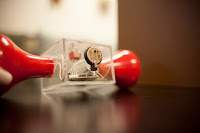Energy storage device could deliver more power than current versions of this technology.
Energy storage devices called supercapacitors have become a hot area of research, in part because they can be charged rapidly and deliver intense bursts of power. However, all supercapacitors currently use components made of carbon, which require high temperatures and harsh chemicals to produce.
Now researchers at MIT and elsewhere have for the first time developed a supercapacitor that uses no conductive carbon at all, and that could potentially produce more power than existing versions of this technology.
The team’s findings are being reported in the journal Nature Materials, in a paper by Mircea Dincă, an MIT associate professor of chemistry; Yang Shao-Horn, the W.M. Keck Professor of Energy; and four others.
“We’ve found an entirely new class of materials for supercapacitors,” Dincă says.
Dincă and his team have been exploring for years a class of materials called metal-organic frameworks, or MOFs, which are extremely porous, sponge-like structures. These materials have an extraordinarily large surface area for their size, much greater than the carbon materials do. That is an essential characteristic for supercapacitors, whose performance depends on their surface area. But MOFs have a major drawback for such applications: They are not very electrically conductive, which is also an essential property for a material used in a capacitor.
“One of our long-term goals was to make these materials electrically conductive,” Dincă says, even though doing so “was thought to be extremely difficult, if not impossible.” But the material did exhibit another needed characteristic for such electrodes, which is that it conducts ions (atoms or molecules that carry a net electric charge) very well.
Read more at New Kind of Supercapacitor Made Without Carbon

No comments:
Post a Comment